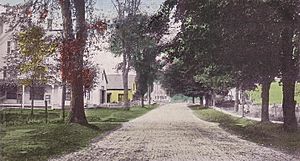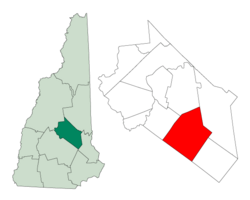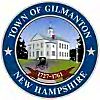Gilmanton, New Hampshire facts for kids
Quick facts for kids
Gilmanton, New Hampshire
|
||
|---|---|---|
|
Town
|
||

High Street in 1910
|
||
|
||

Location in Belknap County, New Hampshire
|
||
| Country | United States | |
| State | New Hampshire | |
| County | Belknap | |
| Incorporated | 1727 | |
| Villages |
|
|
| Area | ||
| • Total | 59.6 sq mi (154.4 km2) | |
| • Land | 57.9 sq mi (150.0 km2) | |
| • Water | 1.7 sq mi (4.4 km2) 2.87% | |
| Elevation | 988 ft (301 m) | |
| Population
(2020)
|
||
| • Total | 3,945 | |
| • Density | 68/sq mi (26.3/km2) | |
| Time zone | UTC-5 (Eastern) | |
| • Summer (DST) | UTC-4 (Eastern) | |
| ZIP codes |
03237 (Gilmanton)
03837 (Gilmanton Iron Works) |
|
| Area code(s) | 603 | |
| FIPS code | 33-28980 | |
| GNIS feature ID | 0873604 | |
Gilmanton is a small town located in Belknap County, New Hampshire, in the United States. In 2020, about 3,945 people lived there. The town is made up of a few smaller areas called villages, including Gilmanton Corners and Gilmanton Ironworks.
Gilmanton became quite famous in the 1950s. This was because people thought the popular book Peyton Place was based on the town. The author, Grace Metalious, actually lived in Gilmanton.
Contents
History of Gilmanton
Gilmanton officially became a town in 1727. It was first known as "Gilmantown." The town was named after the Gilman family, who were among the first settlers from Exeter. Twenty-four members of the Gilman family received land grants here. Other families connected to the Gilmans, like the Dudleys and Folsoms, also received land.
At one point, Gilmanton was the second-largest town in New Hampshire, right after Portsmouth. The original town was much bigger than it is today. It included areas that are now separate towns or villages, like Belmont and Gilford. One area, first called "Averytown," was known for an iron-mining project that didn't make money. Today, this area is still known as Gilmanton Iron Works.
Gilmanton Academy and Seminary
Gilmanton Academy was started in 1794. It was one of the first three academies, or special schools, in New Hampshire. The first building burned down in 1808. The second building also burned in 1894. The building that stands today now holds the town's offices.
The Gilmanton Theological Seminary was also part of the original plan for Gilmanton Academy. This was a school for religious studies. The first professor started teaching there in 1835. By 1841, a large brick building was finished for the seminary.
Geography and Nature
Gilmanton covers about 154.4 square kilometers (about 59.6 square miles). Most of this area, about 150.0 square kilometers (57.9 square miles), is land. The rest, about 4.4 square kilometers (1.7 square miles), is water. This means about 2.89% of the town is covered by water.
In 2004, a study of the town's natural resources was done. It noted Gilmanton's nine town forests. It also highlighted other protected areas, including both dry and wet lands. The study found important plant species living there too.
Mountains and Lakes
The highest point in Gilmanton is Mount Mack. It stands about 593 meters (1,945 feet) above sea level. Mount Mack is located on the border with Gilford.
You can find Crystal Lake in the eastern part of town. Shellcamp Pond is located in the western part. All the water in Gilmanton eventually flows into the Merrimack River. This river is part of a large watershed.
Roads and Villages
Four state roads serve the town: Route 106, Route 129, Route 107, and Route 140. Route 107 is part of an old road important in New Hampshire's early days. Route 106 is a busy road connecting Laconia and Concord. Route 140 runs east-west from Tilton to Alton.
The main intersection of Route 107 and Route 140 is at Gilmanton Corners. This is one of the town's two main villages. Gilmanton Corner is home to several historic buildings, like Gilmanton Academy and Centre Congregational Church. Gilmanton Ironworks is in the eastern part of town, near Crystal Lake.
Neighboring Towns
Gilmanton shares its borders with these towns:
- Gilford (to the north)
- Alton (to the east)
- Barnstead (to the southeast)
- Loudon (to the south)
- Canterbury (to the southwest)
- Belmont (to the west)
Population Information
| Historical population | |||
|---|---|---|---|
| Census | Pop. | %± | |
| 1790 | 2,613 | — | |
| 1800 | 3,752 | 43.6% | |
| 1810 | 4,338 | 15.6% | |
| 1820 | 3,752 | −13.5% | |
| 1830 | 3,816 | 1.7% | |
| 1840 | 3,485 | −8.7% | |
| 1850 | 3,282 | −5.8% | |
| 1860 | 2,373 | −27.7% | |
| 1870 | 1,642 | −30.8% | |
| 1880 | 1,485 | −9.6% | |
| 1890 | 1,211 | −18.5% | |
| 1900 | 1,100 | −9.2% | |
| 1910 | 968 | −12.0% | |
| 1920 | 814 | −15.9% | |
| 1930 | 676 | −17.0% | |
| 1940 | 708 | 4.7% | |
| 1950 | 754 | 6.5% | |
| 1960 | 736 | −2.4% | |
| 1970 | 1,010 | 37.2% | |
| 1980 | 1,941 | 92.2% | |
| 1990 | 2,609 | 34.4% | |
| 2000 | 3,060 | 17.3% | |
| 2010 | 3,777 | 23.4% | |
| 2020 | 3,945 | 4.4% | |
| U.S. Decennial Census | |||
In the early years of the United States, Gilmanton was a much larger town in terms of population. It was ranked among the top 40 most populated places in the country in the 1790, 1800, and 1810 censuses.
According to the 2000 census, Gilmanton had 3,060 people living in 1,165 households. About 33.1% of these households had children under 18. The average household had 2.62 people. The median age in town was 40 years old.
Fun Places to Visit
- Carpenter Museum of Antique Outboard Motors
- Crystal Lake
- Griswold Scout Reservation which includes Hidden Valley Scout Camp and Camp Bell, Boy Scouts of America
- Village of Gilmanton Ironworks
Historic Buildings and Sites
These places in Gilmanton are listed on the National Register of Historic Places, meaning they are important to the country's history:
- Centre Congregational Church
- First Baptist Church of Lower Gilmanton
- Gilmanton Academy
- Smith Meeting House
Famous People from Gilmanton
Many interesting people have connections to Gilmanton:
- John B. Bachelder (1825–1894), a painter, photographer, and historian.
- William Badger (1779–1852), who owned a mill and became the 15th governor of New Hampshire.
- Curtis Coe Bean (1828–1904), a politician.
- Rudi Blesh (1899–1985), a jazz critic and fan.
- John C. Chase (1870–1937), a shoe worker and politician.
- David Cote (born 1969), an author and New York theater critic who grew up in Gilmanton.
- Ira Allen Eastman (1809–1881), a U.S. congressman.
- Nehemiah Eastman (1782–1856), another U.S. congressman.
- George G. Fogg (1813–1881), a U.S. senator and diplomat who started his law practice in Gilmanton Iron Works.
- John R. French (1819–1890), a U.S. congressman.
- Charles A. Gilman (1833–1927), who became the 9th lieutenant governor of Minnesota.
- Dudley Leavitt (1772–1851), an author and publisher. He lived in Gilmanton when he started the Gilmanton Gazette newspaper and an almanac. He was also a selectman, a local government official.
- Grace Metalious (1924–1964), the famous author of Peyton Place.
- Charles H. Peaslee (1804–1866), a U.S. congressman.
- William Prescott (1788–1875), a doctor, politician, and naturalist.
- Edwin David Sanborn (1808–1885), an educator.
- John Sewell Sanborn (1819–1877), an educator, judge, and Canadian politician.
- David Sellin (1930–2006), an art historian and curator for the United States Capitol.
- Thorsten Sellin (1896–1994), a sociologist and criminologist who passed away in Gilmanton.
- Ainsworth Rand Spofford (1825–1908), a journalist and publisher who became the sixth Librarian of Congress.
- Henry M. Spofford (1821–1880), a judge.
- Nathaniel Upham (1774–1829), a politician and educator. He married Judith Cogswell from Gilmanton and lived in the town for a short time.
Images for kids
-
Crystal Lake in 1909
See also
 In Spanish: Gilmanton (Nuevo Hampshire) para niños
In Spanish: Gilmanton (Nuevo Hampshire) para niños






